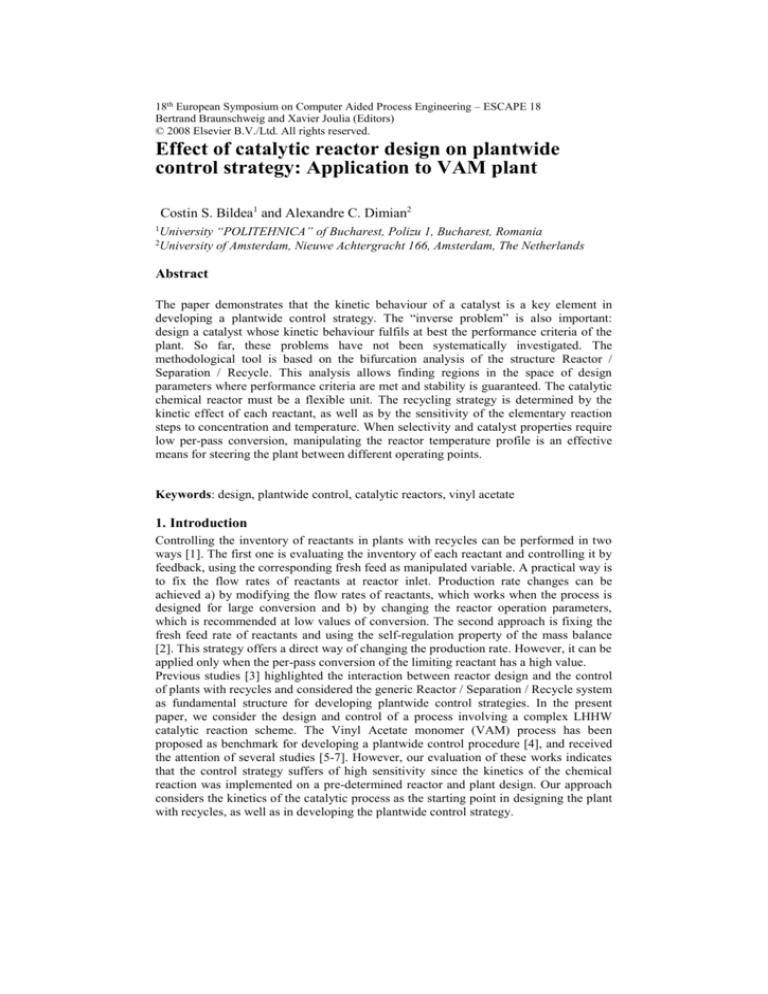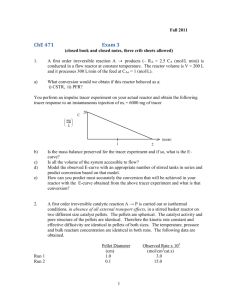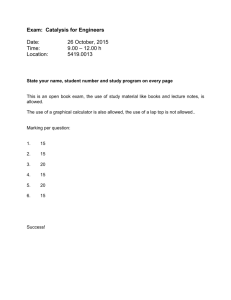
18th European Symposium on Computer Aided Process Engineering – ESCAPE 18
Bertrand Braunschweig and Xavier Joulia (Editors)
© 2008 Elsevier B.V./Ltd. All rights reserved.
Effect of catalytic reactor design on plantwide
control strategy: Application to VAM plant
Costin S. Bildea1 and Alexandre C. Dimian2
1
2
University “POLITEHNICA” of Bucharest, Polizu 1, Bucharest, Romania
University of Amsterdam, Nieuwe Achtergracht 166, Amsterdam, The Netherlands
Abstract
The paper demonstrates that the kinetic behaviour of a catalyst is a key element in
developing a plantwide control strategy. The “inverse problem” is also important:
design a catalyst whose kinetic behaviour fulfils at best the performance criteria of the
plant. So far, these problems have not been systematically investigated. The
methodological tool is based on the bifurcation analysis of the structure Reactor /
Separation / Recycle. This analysis allows finding regions in the space of design
parameters where performance criteria are met and stability is guaranteed. The catalytic
chemical reactor must be a flexible unit. The recycling strategy is determined by the
kinetic effect of each reactant, as well as by the sensitivity of the elementary reaction
steps to concentration and temperature. When selectivity and catalyst properties require
low per-pass conversion, manipulating the reactor temperature profile is an effective
means for steering the plant between different operating points.
Keywords: design, plantwide control, catalytic reactors, vinyl acetate
1. Introduction
Controlling the inventory of reactants in plants with recycles can be performed in two
ways [1]. The first one is evaluating the inventory of each reactant and controlling it by
feedback, using the corresponding fresh feed as manipulated variable. A practical way is
to fix the flow rates of reactants at reactor inlet. Production rate changes can be
achieved a) by modifying the flow rates of reactants, which works when the process is
designed for large conversion and b) by changing the reactor operation parameters,
which is recommended at low values of conversion. The second approach is fixing the
fresh feed rate of reactants and using the self-regulation property of the mass balance
[2]. This strategy offers a direct way of changing the production rate. However, it can be
applied only when the per-pass conversion of the limiting reactant has a high value.
Previous studies [3] highlighted the interaction between reactor design and the control
of plants with recycles and considered the generic Reactor / Separation / Recycle system
as fundamental structure for developing plantwide control strategies. In the present
paper, we consider the design and control of a process involving a complex LHHW
catalytic reaction scheme. The Vinyl Acetate monomer (VAM) process has been
proposed as benchmark for developing a plantwide control procedure [4], and received
the attention of several studies [5-7]. However, our evaluation of these works indicates
that the control strategy suffers of high sensitivity since the kinetics of the chemical
reaction was implemented on a pre-determined reactor and plant design. Our approach
considers the kinetics of the catalytic process as the starting point in designing the plant
with recycles, as well as in developing the plantwide control strategy.
2
Bildea and Dimian
2. Process design
The manufacturing of vinyl acetate by the oxy-acetylation of ethylene is described by
the following gas-phase catalytic reaction:
C2H4 + CH3COOH +0.5O2 → C2H3OOCCH3 + H2O
rH = -176.2 kJ/mol
A highly undesired secondary reaction is combustion of ethylene to CO2, which lowers
the yield and complicates the removal of the reaction heat:
rH = -1322.8 kJ/mol
C2H4 + 3O2 → 2CO2 + 2H2O
The catalyst plays a crucial role in the technology. A typical modern catalyst consists of
0.15-1.5 wt% Pd, 0.2-1.5 wt% Au, 4-10 wt% KOAc on silica spherical particles of 5
mm [8]. The very fast reaction takes place inside a thin layer (egg-shell catalyst).
Preferred conditions are temperatures around 150 to 160 °C and pressures 8 to 10 bar.
Hot spots above 200 °C lead to permanent catalyst deactivation. The excess of ethylene
to acetic acid is 2:1 to 3:1. Because of explosion danger, the oxygen concentration in the
reaction mixture should be kept below 8%. Small amount of water in the initial mixture
are necessary for catalyst activation. The dilution of the reaction mixture with inert gas
is necessary because of high exothermic effect. Accordingly, the reactor is designed at
low values of the per-pass conversions, namely 15 – 35% for the acetic acid and 8-10%
for ethylene. The above elements formulate hard constraints both for design and for
plantwide control.
Analyzing the mechanism of the catalytic reaction allows the identification of the major
factors that affect the reactor design. The reaction kinetics is not sensitive to the
concentration of the acetic acid, but the presence of some water is necessary to activate
the catalyst. On the contrary, ethylene and oxygen are involved in kinetics through a
complex adsorption/surface reaction mechanism. The catalyst manifests high activity
and selectivity. The power-law kinetics involves only ethylene and oxygen [8]:
1
rVA k1 pC
p 1
H O
2
4
2
where α1 is 0.35 - 0.38 and β1 0.18 - 0.21. The reaction constant is given by
k1 A1 exp( E1 / RT ) in which the energy of activation depends on the Pd content, for
example 39 kJ/mol for Pd 1% and 17.3 kJ/mol for Pd 5%. A similar kinetic expression
describes the secondary combustion reaction, but with reaction orders very different
compared to the main reaction:
2
2
rCO2 k2 pC
pO
2H4
2
Table 1. Kinetic parameters for vinyl acetate synthesis over a Pd/Au/SiO2 catalyst [9,10]
Reactions
Power-law
kinetics
C2H4
O2
C2H4+CH3COOH+0.5O2
0.36
0.20
C2H4 +3O2 → 2CO2 + 2H2O
-0.31
0.82
* reaction rate in mol/litre-catalyst/sec.
Kinetic constants
E (J/mol)
15000
21000
A1
2.65E-04
7.50E-04
A2
7.95E-05
2.25E-04
Effect of catalytic reactor design on plantwide control strategy
3
SEP
MIXER
Figure 1 Design of the reactor for vinyl acetate manufacturing in a recycle system
Figure 1 presents the Reactor / Separation / Recycle structure used for performing
reactor design and bifurcation analysis. Because of incomplete conversion, both
ethylene and acetic acid are recycled. The recycle policy should maintain an
ethylene/acetic acid ratio of 3 : 1, as well as oxygen concentration at reactor inlet bellow
8 vol%. The choice of gaseous inert is a key design decision. Some reports [4-7]
consider ethane (impurity in the fresh feed), but this solution is not adopted here.
Because CO2 is produced by reaction in large amount, its use as inert in a concentration
of 10-30 % vol is the most economical [8]. However, the presence of CO has to be
prevented since this is a catalyst poison.
3. Plantwide control
The main goals of the plantwide control system are to ensure safe operation, desired
production rate and product quality, and to optimize the efficiency of using the material
and energetic resources. Figure 2 presents the control structure around the chemical
reactor. Safety is essential. Therefore, the oxygen is added under concentration control,
in a mixing chamber placed behind concrete walls. Secondly, the cooling should avoid
reaction runaway. Several temperature measurements are placed along the reactor bed
and the highest value is selected as the process variable. The manipulated variable of the
control loop is the steam generator pressure, which directly influences the coolant
temperature. The water level in the steam generator is controlled by the water makeup.
Note that using a simple feedback loop may not work. When the steam rate increases,
the correct action is to add more water as makeup. However, the pressure
simultaneously decreases. The lower pressure means that, initially, the steam bubbles
will occupy a larger volume, and the liquid level will increase. A feedback levelcontroller will wrongly decrease the water make-up rate. Therefore, the steam rate is
measured and the required water makeup is calculated. This feedforward action is
combined with the feedback provided by the level controller.
As recommended in previous works, the inventory of reactants in the plant is
maintained by fixing the reactor-inlet flows. Acetic acid is taken with constant rate from
a storage tank, and the fresh feed is added on level control. The gas rate going to the
evaporator is a good estimation of the ethylene inventory. Therefore, this flow is kept
constant by adjusting the fresh ethylene feed. The fresh oxygen rate is manipulated by a
concentration control loop, as previously explained.
4
Bildea and Dimian
TC
Steam
O2
F
FF
C2H4
recycled
+
PC
TC
CC
+
LC
T
Reactor
T
HS
FC
T
Steam
generator
C2H4
fresh
FC
AcOH
recycled
PC
TC
Evaporator
AcOH
fresh
VAc crude
to separation
FC
LC
AcOH
storage
FC
AcOH
to separation
Figure 2. Control structure for fresh feeds and around chemical reactor
CO2
removal
CO2
C2H4
recycled
FC
CC
AcOH
PC
FC
AcOH
C-4
C-1
LC
PC
PC
TC
3Flash
C-1
Decanter
LC
TC
FC
LC
C-5
LC
PC
TC
LC
PC
LC
LC
VAc
C-3
T-1
VAc crude
from reactor
PC
LC
TC
FC
C-6
TC
Water
Water
AcOH
to storage
Figure 3. Control structure of the separation section
The separation section takes advantage from the heterogeneous azeotrope formed by
vinyl acetate and water. Significant energy saving, up to 70 %, can be obtained by
Effect of catalytic reactor design on plantwide control strategy
5
making use of a dehydration gas pre-treatment. In this way the exothermic reaction can
cover up to 90 % from the energy requirements of the distillations.
The control of the separation section is presented in Figure 3. Because the distillate
streams are recycled within the separation section, their composition is less important.
Therefore, columns C-3, C-5 and C-6 are operated at constant reflux, while boilup rates
are used to control some temperatures in the lower sections of the column. For the
absorption columns C-1 and C-4, the flow rates of the absorbent (acetic acid) are kept
constant. The concentration of CO2 in the recycle stream is controlled by changing the
amount of gas sent to the CO 2 removal unit. Temperature and pressure control loops are
standard.
In Reactor / Separation / Recycle systems, two strategies can be employed to achieve
production rate changes. The first one, by manipulating the reactor inlet flows, does not
work here: the acetic acid does not influence the reaction rate, the per-pass conversion
of ethylene is very low (10%), while the reactor-inlet oxygen concentration is restricted
by the safety concerns. Therefore, the second strategy manipulating the reaction
conditions is applied.
4. Results
Figure 4 shows results of simulation in Aspen DynamicsTM, for the following scenario:
the plant is operated at the nominal steady state for 1 hour. Then, the coolant
temperature is increased from 413 K to 425 K and simulation is continued for 2 hours.
The maximum temperature inside the reactor increases from 455 K (at 0.8 m from
reactor inlet) to 469 K (at 1.2 m from inlet). The higher temperature results in higher
reaction rates, less reactants being recycled. The gas recycle is the fastest, and the
ethylene feed is the first to be adjusted. Then, more oxygen is added by the
concentration controller. The dynamics of the liquid recycle is slower and it takes about
0.5 hours until the acetic acid feed reaches the new stationary value. The vinyl acetate
production rate increases from 154 kmol/h to 171 kmol/h. At time t = 3 hours, the
coolant temperature is reduced to 400 K, and the simulation is run for another 2 hours.
The maximum reactor temperature drops to 452 K (near reactor inlet) and the
production rate is decreased to 134 kmol/h. During the entire simulation, the oxygen
concentration stays very close to the setpoint of 6%. Moreover, the concentration of the
vinyl acetate product is above the 99.98% specification.
(a)
(b)
Ethylene
180
160
Acetic acid
140
120
Oxygen
100
80
50
180
Water
160
Vinyl acetate
40
30
140
20
120
CO2
10
100
80
0
1
2
3
time / [h]
4
5
Flow rate / [kmol/h]
200
Flow rate / [kmol/h]
Flow rate / [kmol/h]
200
0
0
1
2
3
4
5
time / [h]
Figure 4. Dynamic simulation results as flow rates of a) fresh reactants and b) products
Similarly to our approach, Luyben and co-workers [4, 5] proposed to fix the reactorinlet flow rate of acetic acid and to use the fresh feed to control the inventory in the
bottom of the acetic-acid distillation column. The two control strategies are equivalent
from a steady state point of view. However, Olsen et al. [6] showed that Luyben’s
6
Bildea and Dimian
structure has an unfavourable dynamics due to the large lag between the manipulated
and controlled variables. The other important control loops in [5] paired the oxygen feed
with oxygen concentration, and ethylene feed with pressure in the system. The
production rate was also manipulated by the setpoint of reactor temperature controller.
Chen and McAvoy [7] applied a methodology where several control structures,
generated on heuristic grounds, were evaluated using a linear dynamic model and
optimal control. Their results also indicate that fixing the reactor-inlet flows is the
recommended strategy.
4. Conclusion
The case study of vinyl acetate synthesis emphasises the benefits of an integrated
process design and plantwide control strategy based on the analysis of the Reactor /
Separation / Recycles structure. The core is the chemical reactor, whose behaviour in
recycle depends on the kinetics and selectivity of the catalyst, as well as on safety and
technological constraints. Moreover, the recycle policy depends on the reaction
mechanism of the catalytic reaction.
The approach in steady state reactor design finds a dynamic equivalent in the plantwide
control strategy. Because of low per pass conversion of both ethylene and acetic acid,
manipulating the flow rate of reactant at reactor inlet has little power in adjusting the
production rate. The reaction temperature profile becomes the main variables for
changing the reaction rate and hence ensuring the flexibility in production. The
inventory of reactants is adapted accordingly by fresh reactant make-up directly in
recycles. Productivity higher than 1000 kg VAM/m3-catalyst/h can be achieved working
at higher temperature and shorter residence time, as well as with good temperature
control. This approach can be seen as generic for low per pass reactions.
References
[1] Bildea C.S., Dimian A.C., Fixing flow rates in recycle systems: Luyben’s rule revisited.
Industrial and Engineering Chemistry Research. 2003; 42: 4578.
[2] Downs J., Distillation Control in a Plantwide Control Environment. In Practical Distillation
Control; Luyben W., Ed.; van Nostrand Rheinhold: New York: 1992.
[3] Bildea C.S., Dimian A.C., Cruz S.C., Iedema P.D., Design of tubular reactors in recycle
systems, Computers & Chemical Engineering 28 (1-2): 63-72, 2004.
[4] Luyben M.L. and Tyreus B.D., An industrial design / control study for the vinyl acetate
monomer process, Comp. Chem. Eng., 1998, 22, 867
[5] Luyben M.L., Tyreus B.D., Luyben W.L. , Plantwide control design procedure, AIChE
Journal, 43 (12), 3161-3174, 1997
[6] Olsen, D., Svrcek, W., Young, B., Plantwide control study of a vinyl acetate monomere
process design, Chem. Eng. Comm, 192 (10), 1243-1257, 2005
[7] Chen, R. and McAvoy, T., Plantwide control system design: methodology and application to a
vinyl acetate process, Ind. Eng. Chem. Res., 42, 4753 – 4771, 2003
[8] Renneke, R. et al., Development of a high performance catalyst for the production of vinyl
acetate monomer, Topics in Catalysis, 38(4), 279-287, 2006
[9] Han, Y. F., Wang J. H., Kumar, D., Yan, Z., Goodman D. W., A kinetic study of vinyl acetate
synthesis over Pd-based catalysts, J. Catalysis, 232, 467, 2005
[10] Han, Y. F., Kumar, D., Sivadinarayana C., Goodman, D. W., Kinetics of ethylene
combustion in the synthesis of vinyl acetate, J. Catalysis, 224, 60, 2004









